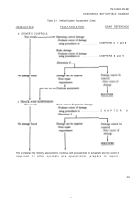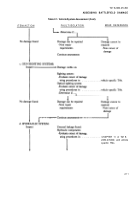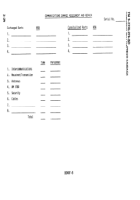TM-9-2350-274-BD - Page 44 of 219
TM 9-2350-274-BD
ASSESSING BATTLEFIELD DAMAGE
SECTION III. Battlefield Damage Assessment/Repair Forms
2-9. General.
a. This section illustrates and describes the forms used in battlefield damage assessment. The forms are
designed to assist Commanders in rapidly assessing battlefield damaged equipment, systematically assess-
ing equipment to determine which subsystem(s) are affected, and the time, personnel and material
required to effect repair. These forms will also assist in performing “vehicle triage. ” Vehicle triage is
defined as a system of deciding in which order battlefield damaged equipment will receive repair,
according to time, urgency, material and personnel required to accomplish the repair. The forms
illustrated are to be used in assessing battlefield damage.
NOTE
These forms are locally reproducible and should be reproduced
in necessary quantities to support local needs.
b. The battlefield damage assessment/repair forms are designed to assure that all necessary aspects of
combat capability are evaluated during the assessment process.
c. All assessment procedures follow the sequence, (1) visually inspect (repair if necessary), (2)
functionally test, (repair if necessary), and (3) assess the performance. The net assessment and field fixes
will enable the vehicle to continue the mission or self-recover, but will typically be more useful to the
MT/MST for scheduling and accomplishing both BDAR “quick fixes” and fix-forward repairs. Battlefield
damage assessment will also provide the Commander with the necessary information for timely decisions
as to whether to continue to “fight the vehicle” or recover it at the appropriate level.
d. Reporting of battlefield damage should be accomplished in accordance with local Standing Operating
Procedures (SOP).
❚
e. There are four forms to be used when assessing battlefield damage, BDARF-5 (System Summary),
BDARF-6 (Hull Damage Report), BDARF-7 (Turret and Cab Damage Report), BDARD-8 (Communi-
cations Damage Report). These forms can be used by the crew, a MT, or MST.
(1) BDARF-5 is used to determine:
Can the vehicle move, shoot and communicate?
What subsystems are affected?
Is the damage repairable?
If repairable, are there limitations?
Estimated time to repair?
2-18
Change 1
Back to Top




















